Legend of the Werewolf (1975)
Directed by: Freddie Francis
Written by: Anthony Hinds
Starring: David Rintoul, Lynn Dalby, Peter Cushing, Ron Moody
UK
AVAILABLE ON DVD and YOUTUBE
RUNNING TIME: 85 mins
REVIEWED BY: Dr Lenera
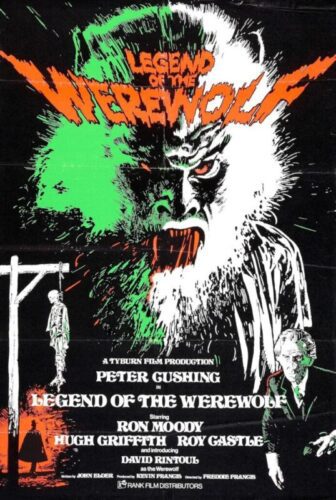
Midnight, Christmas Eve, in the mid-19th century. Two fugitives fleeing persecution stop by the roadside for the woman to have her baby. The mother dies, and the father is slaughtered by wolves who carry the baby off. Years later, a trio of circus performers find the boy and use him as an attraction called the “Wolf Boy”. He’s named Etoile, and loses his wolfish aspects, and his public appeal, as he grows up. One night, Etoile changes into a wolfman under the influence of the full moon, and kills a circus member before fleeing. In Paris he becomes a zoo worker, and all seems well until Etoile takes a shine to prostitute Christine. His lust and jealousy might just bring the beast out in him again….
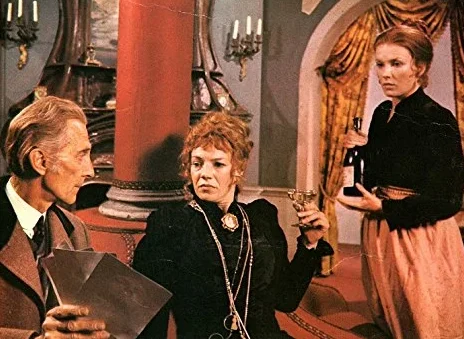
When I was young, this film used to quite often be showing on BBC2 late at night, though up until the other day I hadn’t seen it in about thirty years. Of course I had sometimes thought of it before, but it didn’t have a DVD release until 2017 which went out of print very quickly, and there hasn’t been a Blu-Ray so far. Presumably there are rights issues. It doesn’t seem to be officially available to stream, but YouTube has had a copy up for some time. For ages I actually thought that it was a Hammer film, but eventually I realised that it was instead an imitation Hammer film, made by a company called Tyburn Pictures which was set up by Kevin Francis, the son of Freddie Francis, a top rate cinematographer who often found himself making horror pictures. Tyburn also made The Ghoul [which was nothing to do with the 1933 movie of the same title] just before. Perhaps because their The Curse Of The Werewolf, despite being very good indeed, was a commercial disappointment, Hammer never made a second werewolf movie, but one can almost see this 1975 effort as one, especially since screenwriter Anthony Hinds rejigs or spins variations on elements from his script for the 1961 Oliver Reed-starrer. One wonders if he was very rushed though, because not a lot makes sense even though there are a few good ideas in there, and some scenes in the film seem cut extremely short, as if they weren’t finished because the money ran out. The budget is too low to either convince nor allow for the visual splendour Hammer were often capable of, and David Rintoul is very bland indeed as our lycanthropic anti-hero, yet the film still manages to convey that fatalistic sense of tragedy which gives some werewolf films a sad power.
It was actually based on two stories. One was written by Kevin Francis and called Plague Of The Werewolves; it was set in Transylvania and had a young Baron attacked by a wolf during his joint engagement / 21st birthday party. He starts feeling and acting oddly while killings soon start to happen. And one was by veteran Hammer producer and screenwriter Hinds, under his usual John Elder alias. He wrote Wolfboy, about a baby taken to safety and raised by wolves, then working at a traveling circus then a zoo as an about who falls for a local prostitute. Francis has said that he and Hinds merged their two tales after which Hinds wrote a script, though, having read condensed versions of both stories, it doesn’t seem that much of Francis’s story was used, though it does seen that Guy Endore’s novel The Werewolf of Paris, which Hinds had supposedly based The Curse of the Werewolf on, was an influence again. The film was shot at Pinewood Studios and Hammer’s favourite outdoor haunt, the neighbouring Black Park, in Buckinghamshire At one point one of the wolves used escaped the set, leading local press to claim it had been mistreated. Kevin Francis refuted this claim, saying that the RSPSA had often been on set; the animal ended up attacking nobody but was still shot by police. After seeing the first cut, it appeared that the film was more about Peter Cushing’s character, Inspector Cataflanque, than Etoile, even though Cataflanque was somebody we knew little about. Fortunately a lot of werewolf shots hadn’t been used and were edited in while only losing a bit of Cushing. Like The Ghoul, Legend Of The Werewolf did mediocre box office and didn’t even get a cinema release in the US. Francis seemed not to have realised that the old style English Gothic had fallen out of fashion, with even some of Hammer’s later pictures having drawn little interest.
The very first shot of woods introduces a gimmick which becomes rather overused; a red filter to convey a werewolf or wolf’s point of view. We hear the voice of Cushing tell us what’s happening onscreen, and just as well, because the footage that we see looks incomplete. A large number of people are being driven from their homeland, and one of them is pregnant and has to stop and have the child. A wolf comes and kills her husband, then it or other wolves – we don’t know because we don’t actually see it – carries off the baby which is then raised in the forest by the animals. We learn that “this story was handed down from generation to generation and retold until it became legend”, and indeed there are lots of legends featuring this kind of story, not to mention Francois Truffaut’s Wild Child which probably hadn’t long been out when Hinds got to work on his screenplay. Into the same forest rides Pamponi and his pathetic excuse for a traveling circus, though things change when he sends his driver out to bring some food and the driver accidently shoots the boy when he rips into a rabbit he intended to shoot. He brings the kicking, screaming and biting child back to Pamponi, who smells a good buck. “He looks like a boy but behaves like an animal”!. “Wolf Boy” soon satisfies crowds feeling cheated by just seeing a poodle standing on two feet and Pamponi’s wife not showing the tattoos of the world’s flags that she has all over her body for modesty, though has to be provoked into acting wild by a few bashes with a stick. Wife also tells Etoile’s [as they name him] fortune, Lawrence Talbot-style, though it’s pretty vague really. “He will meet a pretty girl, and will love her to death”, which could easily be taken as a really good thing, a prediction of a happy life, but of course we know that it’s not. Indeed that night an adult Etoile, who’s become less and less animalistic, changes into a werewolf and kills one of Pamponi’s assistants. If only he’d killed the unscrupulous Pamponi too!
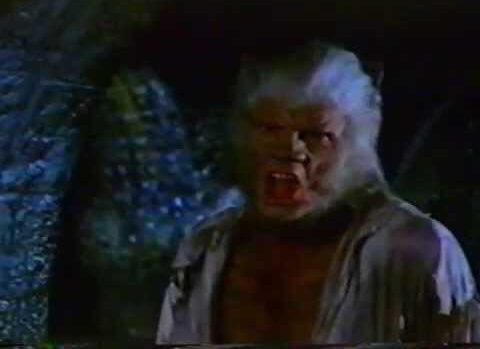
This is all just in the first twenty minutes, and you can certainly say that, in contrast with The Curse Of The Werewolf which only has us meet its main protagonist as an adult, Legend Of The Werewolf wastes no time in getting on with it, though you could also say that it goes a bit too fast through its early section. Etoile arrives in Paris, and stroke a wolf in a cage, which leads to him becoming assistant to a zookeeper. “I’ll give you a hand – a bit later” says the Zookeeper, necking a bottle of something, but he’s impressed with the way Etoile is tough with kids who throw stones at the animals. However, that same day, three prostitutes from a nearby brothel visit to have lunch, and Etoile is smitten by Christine, taking her comment about “customers” to mean that she works in a “shop”. But when he’s turned away from the brothel when he asks to take Christine [such a common name in these films] dancing, he climbs in through the window and sees her with a client. His 1961 predecessor turned into a werewolf due to sexual frustration, in another brothel, because he couldn’t be intimate with the girl he loves. Here, Etoile transforms due to sexual jealousy. He attacks the guy who’s with Christine and is thrown out but not persecuted because the client is the Chief of Police. However, he then transforms repeatedly and sets about killing Christine’s clients, then anyone he comes across at night, and is helped in his rampages by quickly learned familiarity with the Paris sewers. The police are typically clueless, but they do have forensic pathologist Cataflanque assisting them, if against their wishes. Cushing has a nice introduction riffing on his Frankenstein role, first dimly seen from a distance doing something to a body while somebody [Inspector Gerard] looms in the foreground and switches on a light, revealing what Paul is doing in more detail. Soon after he shows a gut he’s just pulled out to unwanted visitors.
In fact the gore level is very low; the werewolf attacks show the odd ripped throat but mostly consist of a red filtered zoom towards victims to be and a closeup of the creature’s bloody mouth, which is perhaps disappointing, especially considering how graphic horror films, even big budget ones, were generally becoming, but then I get the impression that Francis didn’t have a lot to work with due to so little money at his disposal, and just did what he could, even though it’s obvious that this is one of his horror films where the first class cinematographer didn’t feel inclined to provide much visual style, unlike The Skull, Nightmare, even Dracula Has Risen From The Grave. There wasn’t even enough money for a full-on transformation sequence, but then again Hammer didn’t bother with one either. When Etoile first changes while a member of the circus, we see him put his hands on his face, then zoom into a closeup of his transformed eyes. Later on we do get a quick dissolve from beast to man, while the werewolf makeup is gradually introduced before being on full view towards the end. It’s a simpler version of Reed’s makeup in 1961, which I was happy with since that makeup is my favourite werewolf makeup of all time. I even liked seeing him talk briefly, which is reminiscent of Werewolf Of London, Universal’s largely forgotten first stab at a werewolf movie which didn’t quite hit the mark yet which I feel is a bit underappreciated. Indeed, Etoile talking in werewolf form adds emotion to his final scenes where he seems to be really fighting his dark side and has a chance at salvation.
Rintoul is really the problem with a lot of this movie; he probably tries but just isn’t an actor anywhere good enough to convey his character’s journey. Just compare him to Reed, or indeed Lon Chaney, who may not have been that good but who carried the right weight of melancholy, tragedy and animal force to convince in his part. He’s oddly best in his scenes with Lynn Darby as Christine, where his awkwardness works rather well. When Etoile asks Christine to marry him despite hardly knowing her, we believe it. Unfortunately Christine is barely a character. Their scenes together seem like a cut down version of what was originally intended, with so much unsaid. Then again the script bizarrely makes a habit of characters referring to things but not actually spelling them out, such as the word “brothel” which we never hear despite its importance in this story. Yet Ron Moody is superbly sleazy as the Zookeeper; it’s funny when he raises his glass to two old ladies outside in a cafe and they look at him in horror and get up and leave. He’s like a more extreme version of Eric Idle’s character in a certain Monty Python sketch. Indeed there are little bits of humour elsewhere, usually involving Cushing, who yet again gives a not just totally professional but spot-on performance; but then did he ever not do so? Did this consummate actor ever just “wing it”? From eating his lunch while reviewing a newly-fresh corpse to his interplay with the brothel’s Madam while fiddling with a frilly garter [Cushing was well known for playing with props], Cushing shows how beloved he still is to so many. Here, it’s ridiculous that his character would own a book on werewolves, yet we buy it because it’s Him. He’s enough on his own to make this somewhat under-achieving yet still quite interesting film worth watching – though it certainly has other qualities. And We Care. Like so much in this film, the climax seems rushed, yet we’re really saddened.




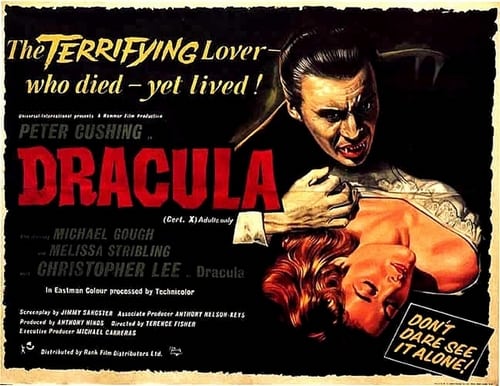
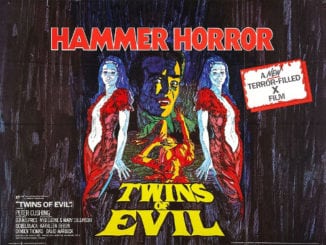
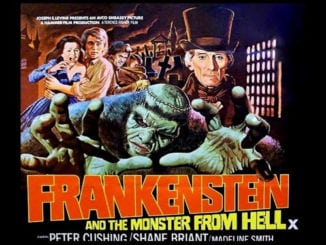
it’s rather sad that whoever owns the rights to LEGEND OF THE WEREWOLF and THE GHOUL is still in 2025 sitting on a distribution seat twiddling their thumbs and refusing to release these Peter Cushing gems on dvd or bluray! It does not give much credit to a star actor like Peter Cushing when other films he has appeared in have had bluray releases-so why the holdup?Loads of Cushing fans would give their right arm to have these-I would!!!